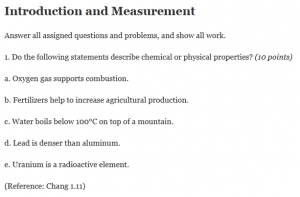Introduction and Measurement

Answer all assigned questions and problems, and show all work.
1. Do the following statements describe chemical or physical properties? (10 points)
a. Oxygen gas supports combustion.
b. Fertilizers help to increase agricultural production.
c. Water boils below 100°C on top of a mountain.
d. Lead is denser than aluminum.
e. Uranium is a radioactive element.
(Reference: Chang 1.11)
2. Classify each of the following as an element, a compound, a homogeneous mixture, or a heterogeneous mixture: (7 points)
a. water from a well
b. argon gas
c. sucrose
d. air
e. dirt
f. a rusty iron nail
g. ozone
3. Express the answers to the following calculations in scientific notation: (12 points)
a. 145.75 + (2.3 × 10 –1)
b. 79,500 ÷ (2.5 × 102)
c. (7.0 × 10–3) – (8.0 × 10–4)
d. (1.0 × 104) × (9.9 × 106)
(Reference: Chang 1.31)
4. What is the number of significant figures in each of the following measurements? (8 points)
a. 4867 mi
b. 56 mL
c. 60,104 ton
d. 2900 g
e. 40.2 g/cm3
f. 0.0000003 cm
g. 0.7 min
h. 4.6 × 1019 atoms
(Reference: Chang 1.33)
5. Express the results in the proper number of significant figures. (12 points)
a. 5.6792 m + 0.6 m + 4.33 m
b. 3.70 g – 2.9133 g
c. 4.51 cm × 3.6666 cm
d. (3 × 104g + 6.827g)/(0.043 cm3 – 0.021 cm3)
(Reference: Chang 1.35)
6. Carry out the following conversions: (16 points)
a. 22.6 m to dm
b. 25.4 mg to kilograms
c. 556 mL to liters
d. 10.6 kg/m3 to g/cm3
(Reference: Chang 1.39)
7. The average speed of helium at 25°C is 1255 m/s. Convert this speed to miles per hour (mph). (4 points)
(Reference: Chang 1.41)
8. How many minutes does it take light from the sun to reach Earth? (The distance from the sun to Earth is 93 million miles; the speed of light is 3.00 × 108 m/s) (4 points)
(Reference: Chang 1.43)
9. Normal body temperature is 78.0°F. Calculate this temperature in degrees Celsius and Kelvin. (4 points)
10. Bromine is a reddish-brown liquid. Calculate its density (in g/mL) if 586 g of the substance occupies 188 mL. (4 points)
(Reference: Chang 1.21)
11. Aluminum is a lightweight metal (density = 2.70 g/cm3) used in aircraft construction, high-voltage transmission lines, beverage cans, and foils. What is its density in kg/m3? (4 points)
(Reference: Chang 1.51)
12. Calculate the mass of a cube of platinum of edge length 0.040 mm (the density of platinum = 21.4 g/cm3). (5 points)
(Reference: Chang 1.57)
13. A piece of silver (Ag) metal weighing 194.3 g is placed in a graduated cylinder containing 242.0 mL of water. The volume of water now reads 260.5 mL. From these data calculate the density of silver in units of g/mL. (5 points)
(Reference: Chang 1.61)
14. Cholesterol in blood is measured in milligrams of cholesterol per deciliter of blood. If the average adult has 6.0 liters of blood, how many grams of cholesterol would be in the blood of an average adult with a cholesterol reading of 185 mg/dL? Density of blood = 1.020 g/mL. (5 points)